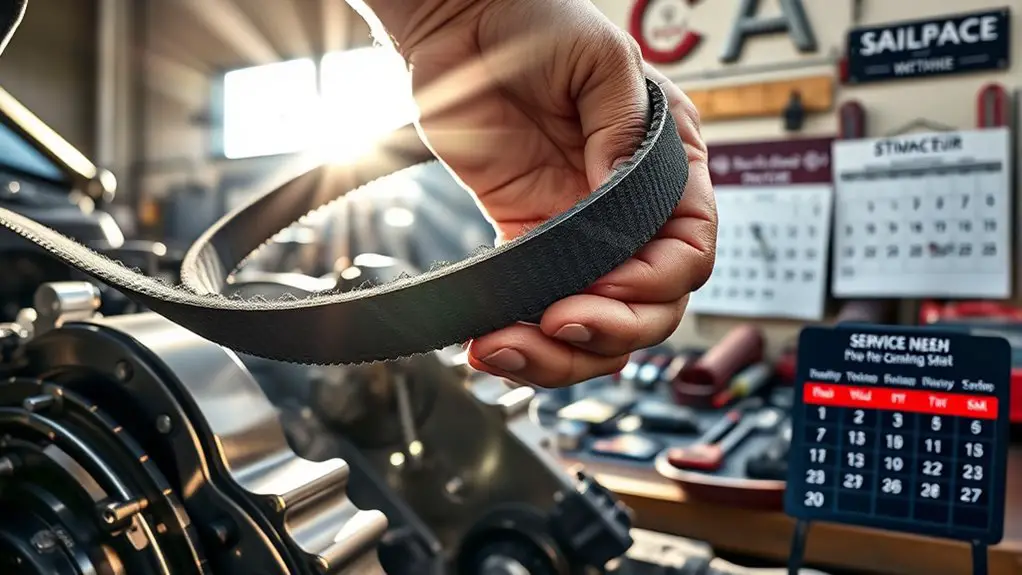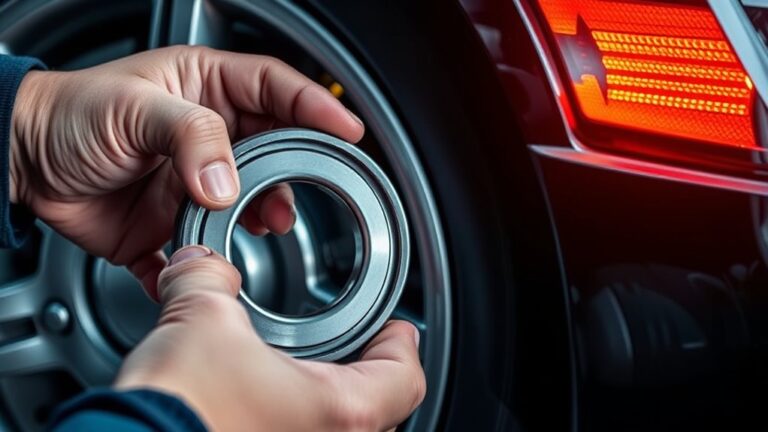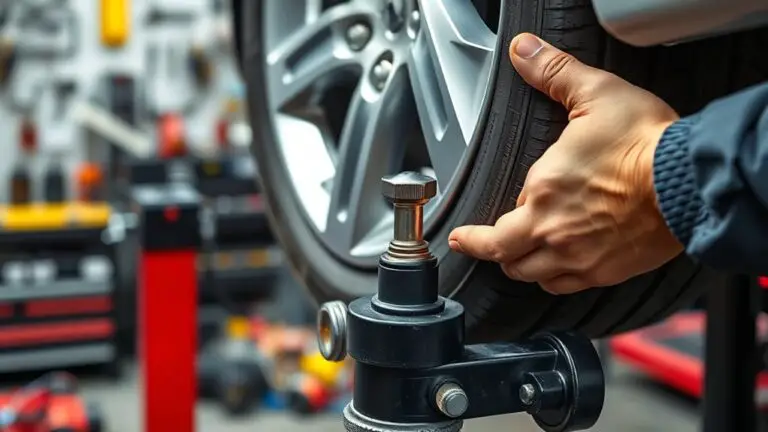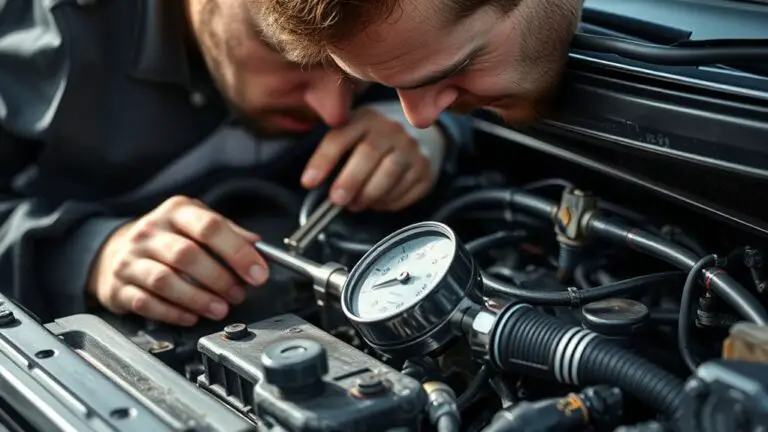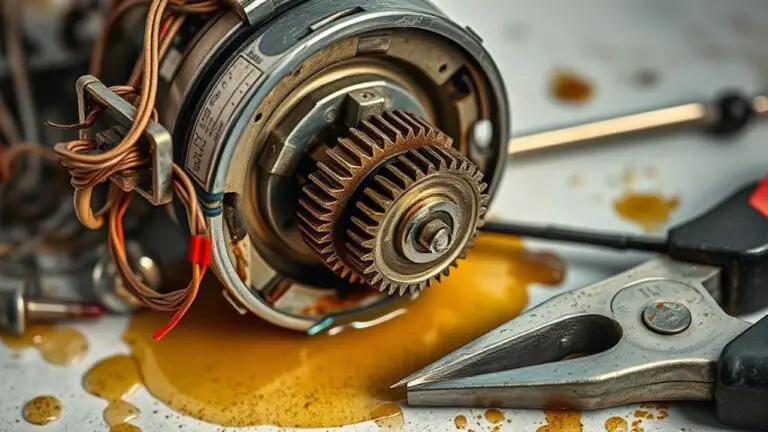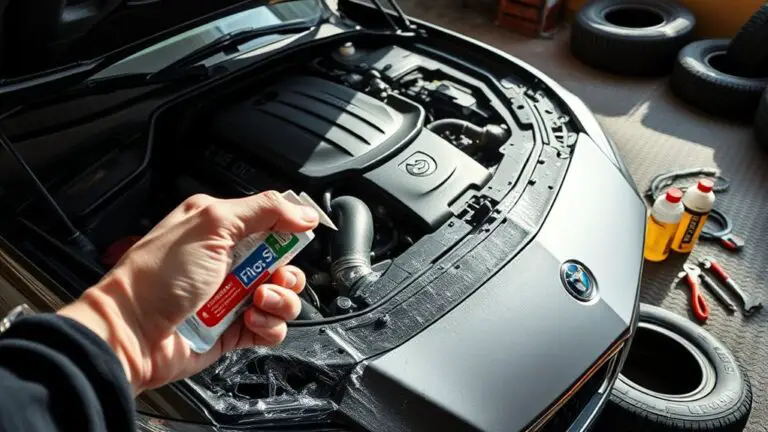When to Replace the Timing Belt: Signs, Procedure and Cost
You should replace your timing belt if you notice visible wear, cracks, or hear unusual engine noises. Signs like engine misfires or rough idling indicate timing issues. It’s essential to regularly inspect the belt, checking tension, alignment, and for missing teeth. The replacement involves specific tools and steps, including aligning timing marks and removing components. Costs vary based on materials and labor, so understanding these factors is important for budgeting. Learn how to properly maintain your timing belt for better longevity.
Understanding the Timing Belt’s Role in Your Engine
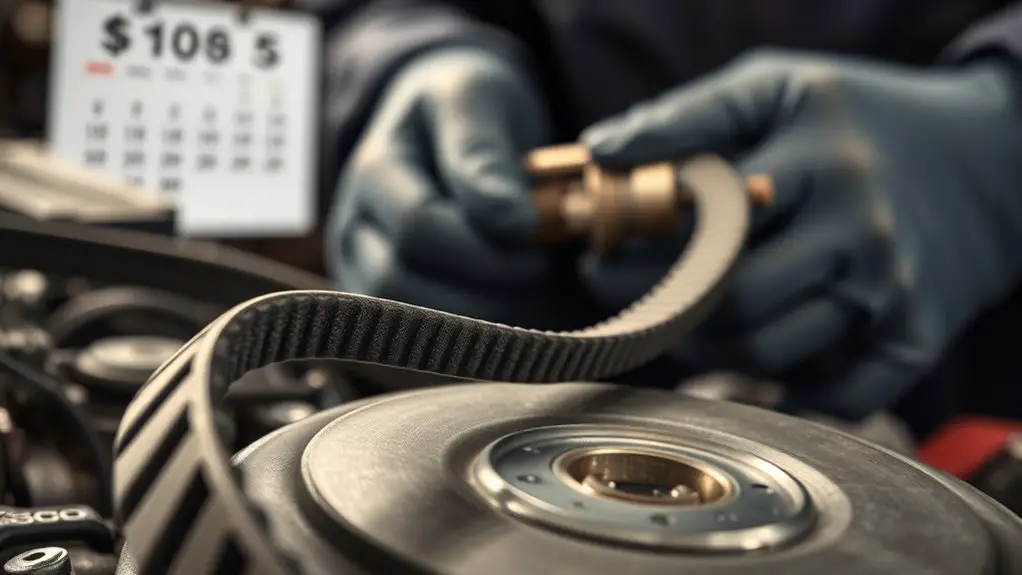
The timing belt is an essential component of your engine’s operation, serving as the connection between the crankshaft and camshaft. Its primary role involves synchronizing the rotation of these two important parts, ensuring that the engine’s valves open and close at the correct times relative to the pistons. This timing belt functionality is significant for ideal combustion, enhancing overall engine performance impact. When your timing belt operates correctly, it supports efficient engine function, contributing to fuel economy and power output.
However, if the belt wears or breaks, it can lead to severe engine damage, affecting performance and potentially causing costly repairs. Understanding the intricacies of timing belt functionality allows you to appreciate its importance in maintaining your vehicle’s health. Regular inspections and timely replacements can help you avoid unnecessary disruptions, ensuring you enjoy the freedom of reliable transportation without unexpected issues compromising your driving experience.
Signs Your Timing Belt Needs Replacement
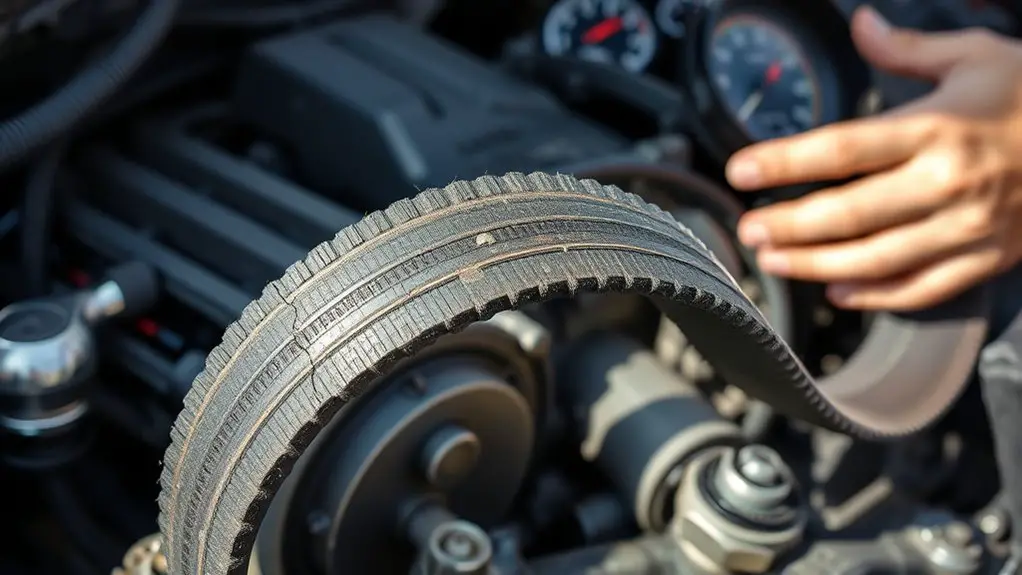
You should be aware of several critical signs that indicate your timing belt may need replacement. Look for visible wear and cracks on the belt, as these can lead to catastrophic engine failure. Additionally, pay attention to any engine misfires or unusual vibrations, as these symptoms often signal timing belt issues.
Visible Wear and Cracks
Visible wear and cracks on a timing belt can signal imminent failure and necessitate immediate attention. If you notice any signs of deterioration, such as fraying, small cracks, or a shiny, smooth surface, it’s essential to act quickly. These signs indicate that your timing belt’s integrity is compromised, directly impacting its longevity. Regular inspections can help catch these issues early, allowing you to replace the belt before it fails. For ideal timing belt longevity, follow maintenance tips like adhering to manufacturer-recommended replacement intervals and keeping the engine properly lubricated. Ignoring visible wear can lead to severe engine damage, so don’t hesitate to consult a professional if you see any warning signs on your timing belt.
Engine Misfires or Noise
Engine misfires and unusual noises can be critical indicators that your timing belt is due for replacement. When the belt wears out or stretches, it can disrupt the engine’s timing, leading to poor engine performance and increased noise. Ignoring these signs might result in severe engine damage, ultimately shortening the belt lifespan.
Here’s a quick reference table to help you identify the symptoms:
| Symptoms | Potential Causes |
|---|---|
| Engine misfires | Worn or stretched timing belt |
| Unusual engine noise | Misalignment or damage to the belt |
| Decreased power output | Timing issues |
| Rough idle | Inadequate timing synchronization |
If you notice any of these symptoms, it’s essential to address them promptly to maintain peak engine performance and guarantee the longevity of your vehicle.
Unusual Engine Vibration
When unusual engine vibrations occur, it often signals that the timing belt may need replacement. These vibrations can stem from a misaligned or worn timing belt, disrupting the engine’s balance. If you notice excessive shaking, especially at idle or during acceleration, it’s essential to investigate further. A failing timing belt can cause improper timing of the engine’s valves, leading to decreased performance and increased wear on engine components. Ignoring these symptoms may result in catastrophic engine failure. You should also check for other indicators, like engine noise or misfires, as they can accompany engine vibrations. To guarantee your vehicle’s longevity, have a professional inspect the timing belt and address any signs of trouble promptly.
The Importance of Regular Timing Belt Maintenance
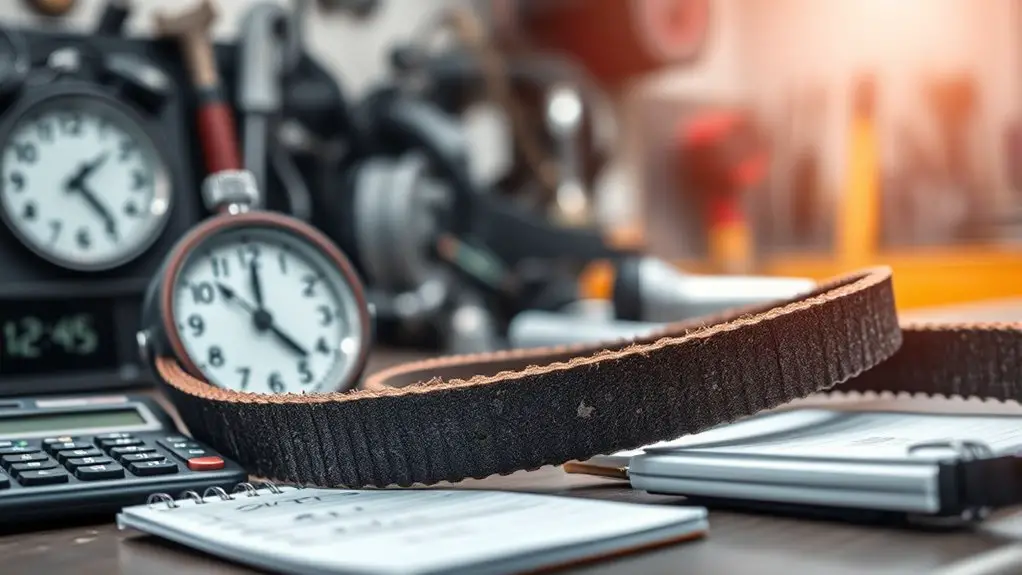
Although often overlooked, regular timing belt maintenance is essential for guaranteeing your vehicle’s reliability and performance. By adhering to a strict maintenance schedule, you can greatly enhance the timing belt longevity, avoiding costly repairs or breakdowns. Here are three key reasons to prioritize timing belt maintenance:
- Preventative Care: Routine inspections can identify wear and tear before they lead to catastrophic failure.
- Optimal Performance: A well-maintained timing belt guarantees precise engine timing, which directly impacts performance and fuel efficiency.
- Cost Savings: Addressing small issues early can save you from the high costs associated with complete belt failure, which often damages surrounding components.
How to Inspect Your Timing Belt
To effectively inspect your timing belt, start with a visual wear assessment, checking for cracks, fraying, or glazing on the belt surface. Next, verify the belt is properly tensioned and aligned, as incorrect tension can lead to premature failure. Finally, listen for any unusual noises during engine operation, as these can indicate underlying issues with the timing belt or its components.
Visual Wear Assessment
Inspecting your timing belt visually can reveal critical signs of wear that may indicate it’s time for a replacement. Regular checks are essential, especially considering the timing belt materials, which can degrade over time. Here are three key signs to look for:
- Cracks or Fraying: Examine the surface for any visible cracks or frayed edges, which signal deterioration.
- Glazing: If the belt appears shiny, it may be overheating, indicating excessive friction or misalignment.
- Missing Teeth: Check for any missing or damaged teeth on the belt, as this can lead to severe engine problems.
Tension and Alignment Check
After evaluating visual wear, the next step is to check the tension and alignment of your timing belt, as both factors play a critical role in the belt’s performance and longevity. Begin with tension adjustment; verify it’s within the manufacturer’s specifications, as too loose or too tight can cause premature wear. Use a tension gauge for accuracy, if available. Next, conduct alignment verification by inspecting the pulleys and sprockets for proper positioning. Misalignment can lead to uneven wear and potential failure. Rotate the engine manually to confirm the belt tracks straight without any deviations. Regular checks can prevent costly repairs and enhance your vehicle’s reliability. Being proactive in these areas keeps your timing belt in ideal condition.
Listen for Noises
Sometimes, unusual noises can signal issues with your timing belt that require immediate attention. If you hear a noisy engine, it’s vital to investigate further. Here are some sounds to listen for:
- Squealing or squeaking: This could indicate improper belt tension or wear, necessitating a check of the belt’s condition.
- Grinding or rattling: These noises might suggest that the timing belt is misaligned or that other components are failing, which can lead to significant engine damage.
- Thumping or banging: Such sounds could mean that your belt is loose or damaged, impacting its ability to maintain necessary tension.
Addressing these signs early can help prevent costly repairs and guarantee your engine runs smoothly.
Common Symptoms of a Failing Timing Belt
As your vehicle ages, it’s crucial to stay alert for signs that your timing belt may be failing. A significant indicator is engine misfires or rough idling, often signaling that the timing belt isn’t aligning components correctly. You might also notice a decrease in engine performance or power, which can be linked to improper timing. Unusual noises, such as grinding or ticking sounds, can indicate wear and tear on the belt or pulleys. Additionally, look for visible signs of wear, like cracks or fraying on the belt itself. If your vehicle’s timing belt lifespan is approaching its recommended replacement frequency, typically between 60,000 to 100,000 miles, these symptoms should prompt immediate attention. Ignoring them could lead to severe engine damage, so addressing potential timing belt issues early can save you from costly repairs and maintain your vehicle’s performance as reliable.
The Timing Belt Replacement Procedure
To replace your timing belt, you’ll need specific tools to guarantee the job’s done correctly. Following a step-by-step guide is vital for maintaining engine integrity and performance. Let’s outline the essential tools and the procedure you’ll need to follow for a successful replacement.
Tools Required
Replacing a timing belt requires several essential tools to guarantee the job is done efficiently and correctly. You’ll need the right timing tools and replacement materials to make sure everything goes smoothly. Here’s a quick list of what you should gather before you start:
- Timing Belt Kit: This includes the new belt, tensioners, and sometimes water pumps.
- Socket Set and Wrenches: A variety of sizes to remove engine components.
- Torque Wrench: To make certain bolts are tightened to the manufacturer’s specifications.
Having these tools at your disposal will not only make the process easier but also lower the risk of damaging your engine. So, get ready, and let’s plunge into the procedure with confidence!
Step-by-Step Guide
Timing belt replacement involves a series of essential steps that guarantee the engine functions smoothly and reliably. First, disconnect the battery and remove any components obstructing access to the timing belt. Next, align the timing marks on the crankshaft and camshaft to maintain proper timing. Once aligned, release the tensioner and remove the old timing belt, inspecting it for wear, which can indicate the end of its lifespan. Before installing the new belt, check the condition of the tensioner and idler pulleys, replacing them if necessary. Finally, reassemble components, ensuring all bolts are torqued to specifications. Following these maintenance tips helps extend the timing belt lifespan, ensuring your engine operates efficiently for years to come.
Tools and Materials Needed for Replacement
A successful timing belt replacement requires a specific set of tools and materials to guarantee the job is done correctly. Knowing the replacement frequency for your vehicle’s timing belt is essential, as this often dictates the quality of the belt material you’ll need. Here’s a concise list to help you prepare:
- Basic Hand Tools: You’ll need wrenches, sockets, and ratchets to remove engine components.
- Timing Belt Kit: This usually includes the new belt, tensioners, and pulleys, ensuring compatibility and longevity.
- Torque Wrench: Important for applying the correct torque settings when reassembling components, preventing future issues.
Having these tools and materials on hand will streamline your replacement process and enhance your vehicle’s performance. Remember, a well-executed replacement boosts reliability and extends the life of your engine.
What to Expect During the Replacement Process
When you begin the timing belt replacement process, expect a series of methodical steps that require attention to detail. First, the engine will need to be cooled down and disconnected from the battery. You’ll remove various components to access the timing belt. Pay special attention to markings on the engine as you align the new belt; this guarantees proper timing.
Here’s a breakdown of what you can expect:
| Step | Description | Importance |
|---|---|---|
| Inspect Components | Check for wear on pulleys and water pump | Guarantees longevity |
| Align Timing Marks | Properly position the new belt | Maintains engine timing |
| Replace Tensioner | Install a new tensioner if needed | Supports timing belt lifespan |
| Reassemble | Put everything back together | Fulfills replacement intervals |
This meticulous process guarantees peak performance, extending your timing belt lifespan and adhering to recommended replacement intervals.
Cost Factors for Timing Belt Replacement
Although many factors influence the cost of replacing a timing belt, understanding these elements can help you budget effectively. Here are three key cost factors to take into account:
- Timing Belt Materials: The quality of the timing belt plays a significant role in pricing. Higher-grade materials typically last longer and can cost more upfront but may save you money in the long run.
- Labor Costs: Labor rates vary based on location and the complexity of your vehicle’s engine. More intricate designs require more time, increasing your overall expenses.
- Additional Parts: Often, it’s wise to replace adjacent components like the water pump or tensioner during the timing belt replacement. This can add to your total cost but is often beneficial for long-term reliability.
Preventative Measures to Extend Timing Belt Life
To guarantee your timing belt lasts as long as possible, regular maintenance checks are essential. Start by adhering to your vehicle manufacturer’s service schedule, which often includes timing belt inspections. During these checks, look for signs of wear such as fraying or cracking, as these can indicate imminent failure.
Your driving habits also play a considerable role in timing belt longevity. Avoid rapid acceleration and sudden stops, as these stress the belt and its components. Additionally, keep your engine properly tuned; a misaligned engine can lead to premature belt wear.
Verify the surrounding components, like the water pump and pulleys, are in good condition, as their failure can compromise the timing belt. Finally, consider using high-quality belts designed for your specific vehicle to enhance durability. By implementing these timing belt maintenance strategies, you’ll greatly extend its lifespan and assure your vehicle runs smoothly.
Frequently Asked Questions
How Long Does a Timing Belt Typically Last?
A timing belt typically lasts between 60,000 to 100,000 miles, depending on your vehicle and driving conditions. To guarantee your engine runs smoothly, follow maintenance recommendations closely. Regular checks, proper tension, and timely replacements can extend its lifespan. Ignoring these factors might lead to costly engine damage, limiting your freedom on the road. Stay proactive in caring for your vehicle, and you’ll enjoy a reliable driving experience for years to come.
Can I Replace the Timing Belt Myself?
Yes, you can replace the timing belt yourself if you have the right tools and skills. You’ll need timing belt tools and a solid understanding of your engine’s layout. Before starting, make certain you’re practicing DIY safety by wearing protective gear and working in a clean, organized space. Follow a detailed guide specific to your vehicle model, as this task requires precision. Remember, any mistakes can lead to serious engine damage, so proceed with caution.
What Happens if I Ignore Timing Belt Replacement?
If you ignore timing belt replacement, you’re risking catastrophic engine failure. Think of it like driving a classic car without oil changes; it might seem fine, but soon enough, it’ll seize. Following your vehicle’s maintenance schedule is essential. A worn or broken belt can lead to valves colliding with pistons, causing expensive repairs. So, don’t gamble with your engine’s health—replace the timing belt on time to guarantee smooth, reliable performance.
Are Timing Belts and Chains the Same?
Timing belts and chains aren’t the same. A timing belt is made of rubber and requires regular replacement, while a timing chain is metal and usually lasts longer. The maintenance differences are significant; you’ll need to monitor the belt for wear and replace it around every 60,000 to 100,000 miles, whereas chains often just require periodic checks. Understanding the timing belt vs chain can help you make informed decisions about your vehicle’s maintenance needs.
Does Engine Type Affect Timing Belt Replacement Cost?
Absolutely, your engine type greatly impacts timing belt replacement costs. Different engine specifications can lead to varied replacement frequencies and complexities. For instance, high-performance engines often require more frequent replacements and specialized parts, raising costs. Conversely, standard engines may follow a more predictable schedule, making replacements less expensive. So, when planning for maintenance, consider your engine’s unique requirements to guarantee you’re prepared for the financial commitment involved in maintaining its performance.

